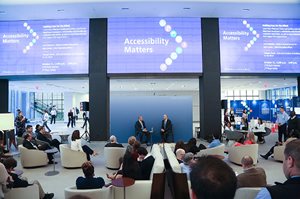5 Web Content Management Trends for 2018
Just because you send emails to your audience by greeting them by their first name doesn’t  mean you are excelling at delivering engaging digital experiences to multiple audiences. Similarly, creating 10 very broad personas doesn’t mean you can rest on your laurels as if you have completed your digital content evolution. In fact, these are just considered tiny little baby steps of that evolution. The Holy Grail that will transform those baby steps into a walk and then a run, is the right web content management system as they are the gravitational center of digital experiences. Increasing demand for personalized and contextualized experiences naturally sets a domino effect in the motion of rising WCM vendors to adopt newer technologies and trends. In this article, we will discuss five of the emerging web content management trends that are poised for a remarkable bloom in 2018.
mean you are excelling at delivering engaging digital experiences to multiple audiences. Similarly, creating 10 very broad personas doesn’t mean you can rest on your laurels as if you have completed your digital content evolution. In fact, these are just considered tiny little baby steps of that evolution. The Holy Grail that will transform those baby steps into a walk and then a run, is the right web content management system as they are the gravitational center of digital experiences. Increasing demand for personalized and contextualized experiences naturally sets a domino effect in the motion of rising WCM vendors to adopt newer technologies and trends. In this article, we will discuss five of the emerging web content management trends that are poised for a remarkable bloom in 2018.
More WCM Providers Offer Cognitive & Analytical Capabilities
The burden of an exponential increase in the amount of data is the 'coup de grâce' for  leveraging the power of it. Good news, one of the premises of artificial intelligence and machine learning algorithms is handling massive amounts of data while extracting value out of it. With this in mind, once the advancements in machine learning and artificial intelligence have been injected into content management systems, understanding the performance of content becomes easier.
leveraging the power of it. Good news, one of the premises of artificial intelligence and machine learning algorithms is handling massive amounts of data while extracting value out of it. With this in mind, once the advancements in machine learning and artificial intelligence have been injected into content management systems, understanding the performance of content becomes easier.
With today’s technology, content creators can analyze how content has come across to readers, which tone resonates with which audience, and so forth. As a content creator and marketer, being able to perform tone analyzing is one of the best features powered by machine learning. As an example of the concept, I can give the IBM Watson Tone Analyzer service as it detects emotional, social, and language tones in written text. The Tone Analyzer provides insight on how the content is coming across to readers, and for each sub-tone, it provides a score between 0 and 1. Some use cases include social listening and audience monitoring, personalized marketing, chatbots, customer engagement monitoring, and quality assurance.
In 2018, we will see more and more content management software providers adding artificial intelligence and natural language technologies to their platforms through acquisitions in an effort to simplify unstructured content management and related processes. Some of the benefits of utilizing cognitive analytics include:
-
Predict a likelihood of conversion through a particular content before it is even published.
-
Understand which content topic is the most relevant for each customer across channels through the integration with customer relationship management systems and marketing automation systems.
-
Deliver user-specific content experiences via metadata that can help them retrieve every occurrence of a specific type of content, such as all product descriptions, positioning statements, value propositions, setup instructions, etc.
-
Eliminate biased decision making processes by taking the guesswork out of what content to produce and which platform to be on.
Omnichannel Drives Experience-as-a-Service (EaaS)
Another emerging new trend in the space is Experience-as-a-Service (EaaS). These days, we  hear “-as-a-service” for pretty much everything we could do in the cloud. Although hearing many different coined versions of “whatever-as-a-service” may feel like the IT industry is overkill with utilizing the term, this is a great model as it allows marketers and content creators to take their assets wherever they need to be, from websites to microsites, from apps to Internet of Things, in order to quickly turn them into digital experiences across digital channels.
hear “-as-a-service” for pretty much everything we could do in the cloud. Although hearing many different coined versions of “whatever-as-a-service” may feel like the IT industry is overkill with utilizing the term, this is a great model as it allows marketers and content creators to take their assets wherever they need to be, from websites to microsites, from apps to Internet of Things, in order to quickly turn them into digital experiences across digital channels.
The shift from a traditional, monolithic architecture to cloud-first, based on containers and microservices has simply been driven by today’s uber-connected consumers’ expectations of having a consistent and relevant experience across all digital touchpoints.
Now that content can be separated from layout, the repurposing and reuse of content to multiple sites, devices, apps and distribution channels are easier with headless or decoupled CMSes. Today, many WCM platforms provide a stateless API that allows users to access and retrieve content and delivery of services through the cloud. When it comes to understanding the benefit of having this type of an architecture, I would like to quote from Navin Nagiah, CEO of DNN Software as he had once used a great analogy to explain it: “Liquid takes the shape of the objects it’s placed in and flows around barriers and obstacles. (With this architecture), your content becomes fluid and adaptable, and can easily be published to any channel.”
Gartner cited in its one of the Magic Quadrant for Web Content Management reports: “Microservices with a high level of interoperability will enable WCM elements to be coupled with different sets of third-party technologies, depending on the requirements of the current phase of the customer's journey.” Additionally, in Forrester’s report, entitled The Rise of the Headless Content Management System, analysts Ted Schadler and Mark Grannan predicted: “Even if web CMS or eCommerce vendors are not going to relinquish control of the presentation layer to a dynamic JavaScript framework like Angular, they will be forced to publish new stateless APIs to deliver content everywhere. Doing this properly will take the vendors years and cost millions or tens of millions of development dollars.”
Considering content is the heart and soul of every strategy, omnichannel marketing strategy has become one of the main focus areas for technology providers as well as content creators. The Washington Post, for instance, analyzes tens of millions of events every night to improve content and ad relevance. Though personalization, micro experiences, machine learning and omnichannel sound like buzzwords, the underlying idea of orchestrating them through a single platform may help organizations set their businesses up to remain with or ahead of the curve not only in 2018 but also over the next 5 years.
Better Security To Prevent Data Breaches from Becoming the ‘New Normal’
As the pace of business and the need for collaboration persist to accelerate, companies are struggling with managing and protecting their sensitive content as well as enabling their expanding teams to collaborate on the same project in real time. On top of that, with cybercriminals becoming more sophisticated and organized, businesses are inevitably faced with data security issues at some point, and sometimes even many large enterprises fail at securing their intellectual property.
One of the high profile cyber-attacks occurred this year was the Home Box Office Inc. (HBO)  hack and the leaked episodes of Game of Thrones, which is the most pirated television show six years in a row, based on George R.R. Martin's legendary book series. From a content management standpoint, the HBO hack, once again, begged the popular question: who’s to blame? Are software vulnerabilities the culprit for this massive leak? Or the organizations’ lack of encryption enforcement? A little bit of both, I would say.
hack and the leaked episodes of Game of Thrones, which is the most pirated television show six years in a row, based on George R.R. Martin's legendary book series. From a content management standpoint, the HBO hack, once again, begged the popular question: who’s to blame? Are software vulnerabilities the culprit for this massive leak? Or the organizations’ lack of encryption enforcement? A little bit of both, I would say.
Nearly 1 million new malware threats are released each day, and cyber criminals get unauthorized access to your site to steal sensitive data such as credit card information through that malware. On the other hand, more and more businesses now utilize cloud services to enable their employees to collaborate through sharing, editing and updating files on the cloud. The problem is though, many of them do not have a comprehensive security protocol to protect sensitive information within the shared files. As a result, this situation leads to increased chances of sensitive data loss through violations of data loss prevention (DLP) activities.
Incorporating with numerous post-production freelancers who transfer sensitive information through personal email accounts and personal devices is the biggest factor to create that security vulnerability. Far worse, there is also this ugly truth where most businesses are not even aware which data set is sensitive, let alone protect it.
Speaking to CMS-Connected, Jon Loew, CEO of AppGuard, a cybersecurity software provider, commented on how enterprises have mistakenly come to believe that numerous endpoint compromises are unavoidable and the new normal:
"Despite the technical nature of cybersecurity, things fall in and out of vogue all the time.  Several alternatives to the big four antivirus vendors have gained acclaim only to lose it after the other shoe dropped. Some examples include application whitelisting, host-based sandboxing, process virtualization, cloud-based sandboxing, anti-exploit (a.k.a., memory protection), and next-gen network appliances. The hangover for machine learning malicious file detection is coming soon as ever more breaches pile up from in-memory and non-malware malicious code attacks as well as from more of the obfuscation tactics that have long fooled traditional antivirus.”
Several alternatives to the big four antivirus vendors have gained acclaim only to lose it after the other shoe dropped. Some examples include application whitelisting, host-based sandboxing, process virtualization, cloud-based sandboxing, anti-exploit (a.k.a., memory protection), and next-gen network appliances. The hangover for machine learning malicious file detection is coming soon as ever more breaches pile up from in-memory and non-malware malicious code attacks as well as from more of the obfuscation tactics that have long fooled traditional antivirus.”
“So now two other relatively new hype cycles are converging: endpoint detection and response (EDR) and behavior analytics. Neither prevents endpoint compromises. Both detect and react afterward. All of these tools have one thing in common; they were hyped by the same market influencers. So, why wouldn’t people believe that endpoint compromises are unavoidable and the new normal? Well, in the next year, you’re going to hear from other people that have been breach free because of something very different." The term you’ll hear from them is adaptive process isolation. The term is new but the technology has been in the field for years.”
Building Web Accessibility into a WCM
The population of those with visual, auditory, physical, speech, cognitive, neurological and  other disabilities can’t afford to be overlooked. As a matter of fact, in the U.S, one out of every five adults has a disability, according to the Centers for Disease Control and Prevention. Some 15% of the world's population, an estimated 1 billion people, have disabilities. The disability market represents an annual disposable income of $544 Billion in the U.S. alone. When friends and family are included, this adds another $3.9 Trillion, according to the data from The Global Economics of Disability Report (Fifth Quadrant Analytics). A Microsoft study conducted by Forrester Research, Inc. suggests 75% of people with disabilities, more than 39 Million people, use computers today. With all these figures in mind, creating an inclusive and accessible society for all, in both a real and virtual world and prohibiting discrimination on the basis of disability are not good enough motivation for you to make your website accessible, there are also two other main reasons to do so.
other disabilities can’t afford to be overlooked. As a matter of fact, in the U.S, one out of every five adults has a disability, according to the Centers for Disease Control and Prevention. Some 15% of the world's population, an estimated 1 billion people, have disabilities. The disability market represents an annual disposable income of $544 Billion in the U.S. alone. When friends and family are included, this adds another $3.9 Trillion, according to the data from The Global Economics of Disability Report (Fifth Quadrant Analytics). A Microsoft study conducted by Forrester Research, Inc. suggests 75% of people with disabilities, more than 39 Million people, use computers today. With all these figures in mind, creating an inclusive and accessible society for all, in both a real and virtual world and prohibiting discrimination on the basis of disability are not good enough motivation for you to make your website accessible, there are also two other main reasons to do so.
The inability to access websites puts not only individuals but also businesses at a great disadvantage. In an interview, Todd Bankofier, the CEO of AudioEye, touched upon the business side of the matter by saying: “Strong, compassionate leaders who are concerned about their ROI are interested in getting everybody the best experience possible when they visit a site." I couldn’t agree more with him as usability and user experience are catalysts to a consumer’s decision journey. However, today, as many as half of the websites are nearly impossible for people with disabilities to browse. Considering the number of people with a disability or age-related limitation is expected to increase, the opportunity lies therein for businesses that aim at expanding their audience and reach.
In recognition of this issue, lately, there has been much more exhortation by governments to encourage digital businesses to make their web presence accessible to all end users. The Bureau of Internet Accessibility, for instance, announced that small businesses could be eligible for a $5,000 tax credit by increasing their website accessibility and making other accommodations to make their business more accessible for persons with disabilities. The IRS guidelines indicate that all efforts to improve website accessibility are eligible for a 50 percent credit for any expenditures over $250, not to exceed $10,250, for a maximum benefit of $5,000. The credit can be subtracted from a business' tax liability.
In 2018, more WCM vendors will adopt robust, more tightly integrated website accessibility capabilities through either acquisitions/partnerships or from building the capabilities in-house. Department of Justice (DOJ), which issues the regulations (Title II and III of the Americans with Disabilities Act (ADA)), considers a website “accessible” if it complies with the Level AA standards of the Web Content Accessibility Guidelines (WCAG) 2.0. While it is not quite possible to fulfill all Level AAA success criteria for some content, today’s technology helps user shave few or no errors at Level A, AA, and AAA on the website.
Here are some website accessibility tips for content creators:
-
When selecting the colors that will be used for the background and text of the website, you should take into account whether those colors will cause users with color blindness or other visual disabilities to be unable to read the text on the site. Use the tools available to ensure if your site’s colors meet accessibility standards. Testing should be done at this early stage.
-
Add appropriate H1 and H2 tags to describe the contents of the page
-
Users with visual impairments often use screen readers that read a site’s content to them aloud and navigating through a site’s content using one of these tools can be cumbersome and tedious. Test your design with screen readers.
-
The majority of the disabled users cannot view Flash. Google, Mozilla, Apple, Facebook, Vimeo, Netflix, The Washington Post, and the U.S. government have already shifted to secure their traffic with encryption through the adoption of HTTPS. You should stop using Flash too in order to make your website accessible.
-
Make sure flashing or strobing images are not present on the site as these effects can trigger seizures in some people.
-
Proper use of headers and subheadings can help screen readers and search engines understand how information is outlined on the page.
-
All PDFs, applets and other site features should be accessible to assistive software or alternative accommodations should be provided.
GDPR Capabilities Will Help Non-Compliant Companies
In my opinion, after a headless CMS approach, one of the hottest topics that have generated so many  discussions was the EU’s General Data Protection Regulation (GDPR) going into effect. As we are getting closer to the European GDPR deadline of May 25, 2018, vendors are releasing new capabilities to help non-compliant companies be ready. A breach of the GDPR can result in fines of up to €20 million or 4% of annual global turnover (whichever is greater). That being said, Gartner predicts that by the end of 2018, more than 50 percent of companies affected by the GDPR will not be in full compliance with its requirements.
discussions was the EU’s General Data Protection Regulation (GDPR) going into effect. As we are getting closer to the European GDPR deadline of May 25, 2018, vendors are releasing new capabilities to help non-compliant companies be ready. A breach of the GDPR can result in fines of up to €20 million or 4% of annual global turnover (whichever is greater). That being said, Gartner predicts that by the end of 2018, more than 50 percent of companies affected by the GDPR will not be in full compliance with its requirements.
When it comes to American companies, collecting an IP address of an EU resident, which is not even considered as personally identifying information in the US., will be enough to trigger the GDPR. As WCM vendors admit that they should share the responsibility of educating their customers on GDPR compliance, this year, we have seen almost every vendor adding baked-in GDPR capabilities to their platforms. Here are some of them that WCM platforms should provide in 2018 before the regulation goes into effect:
-
Personal data flow documentation
-
Consent management
-
Access all the data processed about a specific data subject
-
An ability to export personal data in commonly used, structured, and machine-readable format
-
An ability to delete collected personal data
Kentico, for instance, is one the vendors which have recently rolled out a number of capabilities that will help businesses comply with the EU’s upcoming GDPR. Karol Jarkovsky, Director of Product at Kentico, told in a CMS-Connected interview: “What we see as our role as a CMS vendor is to basically help organizations with their efforts to comply with the GDPR, there is never going to be a magic button that you can press and that’s it but as a vendor we can help those businesses fulfill the rights of the data subjects, to help businesses prove to authorities that they took all the necessary steps to comply with the GDPR.”
My POV
Digital businesses are on the lookout for a comprehensive interface with their company’s entire information ecosystem such as inventory systems, customer relationship management (CRM) systems, enterprise resource planning (ERP) systems, and more.
The increasing demand for being armed with a rich content management system (CMS) around a commerce engine drives is not a new trend but will continue to drive many marketers and merchandisers to take a Content-first and Commerce-first approach to commerce as they benefit from the best of both worlds. On top of that, many organizations also feel more efficient when they integrate a standalone best-of-breed e-commerce solution with their digital ecosystem.
Content management systems are becoming more robust every year, but still, just like every other technology, it is inanimate and we, as human beings, are supposed to breathe life into it. That’s why, before making a technology decision, organizations should first, truly understand what kind of message resonates with their audience, then which channels and devices they are spending their time on and from there, how they can integrate their message with those channels.

Venus Tamturk
Venus is the Media Reporter for CMS-Connected, with one of her tasks to write thorough articles by creating the most up-to-date and engaging content using B2B digital marketing. She enjoys increasing brand equity and conversion through the strategic use of social media channels and integrated media marketing plans.